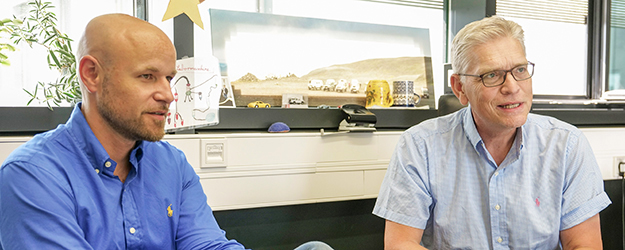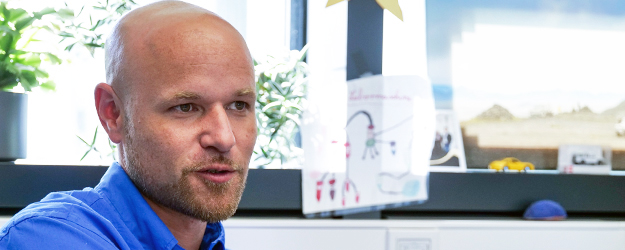29 August 2019
For decades, researchers at the University Medical Center of Johannes Gutenberg University Mainz (JGU) have been doing outstanding work in the field of immunology. In 2017, their work was further enhanced through the establishment of the Collaborative Research Center (CRC) 1292 on "Targeted influencing of the convergent mechanisms of ineffective immunity in cancer and chronic infections". The German Research Foundation (DFG) agreed to fund it to the tune of EUR 9.7 million for an initial period of four years.
Professor Hansjörg Schild summarizes the special character of the project, initiated two years ago, as follows. "For a biomedical consortium, our collaborative research center is highly interdisciplinary. It does not focus exclusively on one disease, which is what distinguishes it from other CRCs. However, by studying both chronic infections and cancers – in other words, both pathogens and tumors – we are broadening our perspectives to cover potential shared features of the development and manifestation of these diseases. By agreeing to support our CRC, the DFG has confirmed that they find this approach expedient. We are naturally delighted about this."
That's the cue for Professor Tobias Bopp to join in the discussion: "If we want to understand certain mechanisms that occur again and again, selecting just one type of tumor is not enough. We need to go down a route that will enable us to make the necessary comparisons. For instance, we have developed an automated approach at the organizational level: There is an unusually extensive exchange of information between our groups so that they learn a great deal from each other."
Immune evasion strategies
The two scientists have met us at the new Paul-Klein-Center for Immune Intervention (PKZI) specifically to describe the work of Collaborative Research Center 1292. The center on the campus of the University Medical Center was opened in the same year that the CRC was launched. Around 200 scientists undertake research here, and it's also the location of the Institute of Immunology, which is jointly led by Schild and Bopp, and where the strands of CRC 1292 converge.
"Our goal is to identify the factors that lead to tumors and chronic diseases establishing themselves in the body," points out Schild. "Cells in our body are continually degenerating, but normally our immune system ensures they don't get past a few divisions. In some cases, however, a tumor continues to grow. The situation is similar when it comes to infections. The body constantly has to deal with pathogens invading from the outside. Usually we don't even notice, as our immune system successfully tackles them. But sometimes organisms that can cause chronic diseases do manage to gain a foothold."
"In both cases, you’ve got elements establishing themselves in the body that, in principle, can be distinguished from the body's own structures," adds Bopp. "This means that the immune system should be able to detect them. But again in both instances, there are certain situations in which the immune system obviously can't or is actively prevented from doing so. We're interested in the reasons for this, and are looking for what these situations have in common." The immune system is outsmarted by what immunologists refer to as ‘evasion strategies’. And it’s these strategies that the CRC is specifically investigating.
Co-opted defense mechanisms
"Tumors and chronic diseases are able to establish a microenvironment that prevents the immune system from eliminating infected or degenerate cells," explains Bopp. "On the one hand, our immune system has very basic functions that are ubiquitous throughout the body, while on the other, it can also operate in a highly tissue-specific manner. As a result, certain populations of regulatory T-cells are very common in some tissues and much less common in others. As a first step, we're interested in finding out, for example, whether mechanisms that attack tumors in the brain are the same as those that operate in the skin or intestines. Then we’ll look at how the tumors render these mechanisms ineffective or even co-opt them for themselves. Once we know how this works, the information may provide the basis for new therapeutic approaches."
Using an example, Bopp describes exactly how cancer can affect the body: "Tumors grow rapidly. To do that, they need a lot of energy. To obtain this energy, they exploit processes associated with wound healing, such as acidification of tissue - this reduction in pH usually occurs in a wound environment while lactic acid can also build up in muscles during exercise, resulting in soreness. As a result, immune-mediated repair mechanisms are activated and inflammation is suppressed. One consequence of this is that the affected tissue is better perfused with blood. This natural process can be co-opted by a tumor, which then becomes vascularized. More veins link to it and supply it with nutrients." Bopp heads the CRC subproject ‘ICER-mediated regulation of macrophage-dependent immune evasion mechanisms of malignant melanomas’, which investigates similar processes.
It has long been known that parallels can be drawn between the evasion strategies used by chronic diseases and tumors. "The procedures we use to treat cancer are often derived from therapies that were originally developed to deal with pathogens," notes Schild. It is common aspects of this kind that the CRC is hoping to identify by sharing information between individual subprojects. "But we also hope we'll discover more details when it comes to the diversity of strategies. This will allow us to target interventions more accurately and with fewer side effects."
Center of intensive fundamental research
In addition to the University Medical Center and JGU, a number of other eminent institutions are involved in CRC 1292. A group at the Paul Ehrlich Institute in Langen, for example, is working on HIV molecules that cause fewer alarmins to be synthesized. Scientists at the Goethe University of Frankfurt are investigating the mechanisms employed by tumors to protect themselves against pre-programmed cell death. And the Charité in Berlin is contributing its expertise on Coxsackie virus infections, which can permanently damage heart muscle.
"We decided to link up with these external projects as they fit in well with our research and because we hope that this will help generate synergistic effects," says Schild, "but most of the research groups are based in Mainz. This makes sense: CRCs are intended to be structural elements designed to build up a research focus, in our particular case, in immunotherapy." That's one reason why a Mainz-based graduate school, which promotes young researchers, has also been integrated.
Immunology in Mainz is characterized by cutting-edge research. "There are four collaborative research centers in the Paul Klein Center alone," says Schild. "There are no similar concentrations of expertise at the University Medical Center." He hopes that CRC 1292 will survive beyond its first four years. "We're only in our second year, but time flies fast when you're doing such extensive research."



